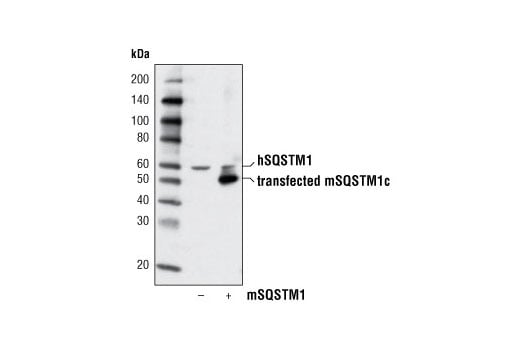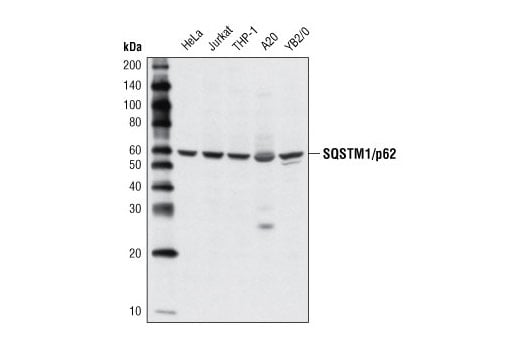 全部商品分类
全部商品分类


1/2
产品介绍
产品介绍
产品信息
荧光素标记
抗原名称
SQSTM1p62

来源纯化
Polyclonal antibodies are produced by immunizing animals with a synthetic peptide corresponding to residues surrounding Gly410 of human SQSTM1/p62 protein. Antibodies are purified by protein A and peptide affinity chromatography.

宿主
Rabbit

商品描述
Product Usage Information
| Application | Dilution |
|---|---|
| Western Blotting | 1:1000 |

分子量
62

研究领域
癌症,细胞生物学,纤维化,代谢,神经科学

应用
反应种属
Human,Mouse,Rat,Monkey,

目标/特异性
Specificity/Sensitivity
SQSTM1/p62 Antibody detects endogenous levels of total SQSTM1/p62 protein.
Species Reactivity:
Human, Mouse, Rat, Monkey

敏感性
Endogenous

背景
背景
Sequestosome 1 (SQSTM1, p62) is a ubiquitin binding protein involved in cell signaling, oxidative stress, and autophagy (1-4). It was first identified as a protein that binds to the SH2 domain of p56Lck (5) and independently found to interact with PKCζ (6,7). SQSTM1 was subsequently found to interact with ubiquitin, providing a scaffold for several signaling proteins and triggering degradation of proteins through the proteasome or lysosome (8). Interaction between SQSTM1 and TRAF6 leads to the K63-linked polyubiquitination of TRAF6 and subsequent activation of the NF-κB pathway (9). Protein aggregates formed by SQSTM1 can be degraded by the autophagosome (4,10,11). SQSTM1 binds autophagosomal membrane protein LC3/Atg8, bringing SQSTM1-containing protein aggregates to the autophagosome (12). Lysosomal degradation of autophagosomes leads to a decrease in SQSTM1 levels during autophagy; conversely, autophagy inhibitors stabilize SQSTM1 levels. Studies have demonstrated a link between SQSTM1 and oxidative stress. SQSTM1 interacts with KEAP1, which is a cytoplasmic inhibitor of NRF2, a key transcription factor involved in cellular responses to oxidative stress (3). Thus, accumulation of SQSTM1 can lead to an increase in NRF2 activity.
1.Kirkin, V. et al. (2009) Mol Cell 34, 259-69.
2.Seibenhener, M.L. et al. (2007) FEBS Lett 581, 175-9.
3.Komatsu, M. et al. (2010) Nat Cell Biol 12, 213-23.
4.Bjørkøy, G. et al. (2006) Autophagy 2, 138-9.
5.Joung, I. et al. (1996) Proc Natl Acad Sci USA 93, 5991-5.
6.Sanchez, P. et al. (1998) Mol Cell Biol 18, 3069-80.
7.Puls, A. et al. (1997) Proc Natl Acad Sci USA 94, 6191-6.
8.Vadlamudi, R.K. et al. (1996) J Biol Chem 271, 20235-7.
9.Wooten, M.W. et al. (2005) J Biol Chem 280, 35625-9.
10.Bjørkøy, G. et al. (2005) J Cell Biol 171, 603-14.
11.Komatsu, M. et al. (2007) Cell 131, 1149-63.
12.Pankiv, S. et al. (2007) J Biol Chem 282, 24131-45.

研究领域
癌症,细胞生物学,纤维化,代谢,神经科学
翻译后修饰
unmodified

制备和贮存
保存方式
Supplied in 10 mM sodium HEPES (pH 7.5), 150 mM NaCl, 100 µg/ml BSA and 50% glycerol. Store at –20°C. Do not aliquot the antibody.
数据库链接
Entrez-Gene ID
8878

UniProt ID
Q13501

参考图片
Western blot analysis of extracts from 293T cells, mock transfected (-) or transfected with mouse SQSTM1 isoform c (mSQSTM1c) construct (+), using SQSTM1/p62 Antibody.
Western blot analysis of extracts from various cell lines using SQSTM1/p62 Antibody.
声明 :本官网所有报价均为常温或者蓝冰运输价格,如有产品需要干冰运输,需另外加收干冰运输费。






 用小程序,查商品更便捷
用小程序,查商品更便捷




